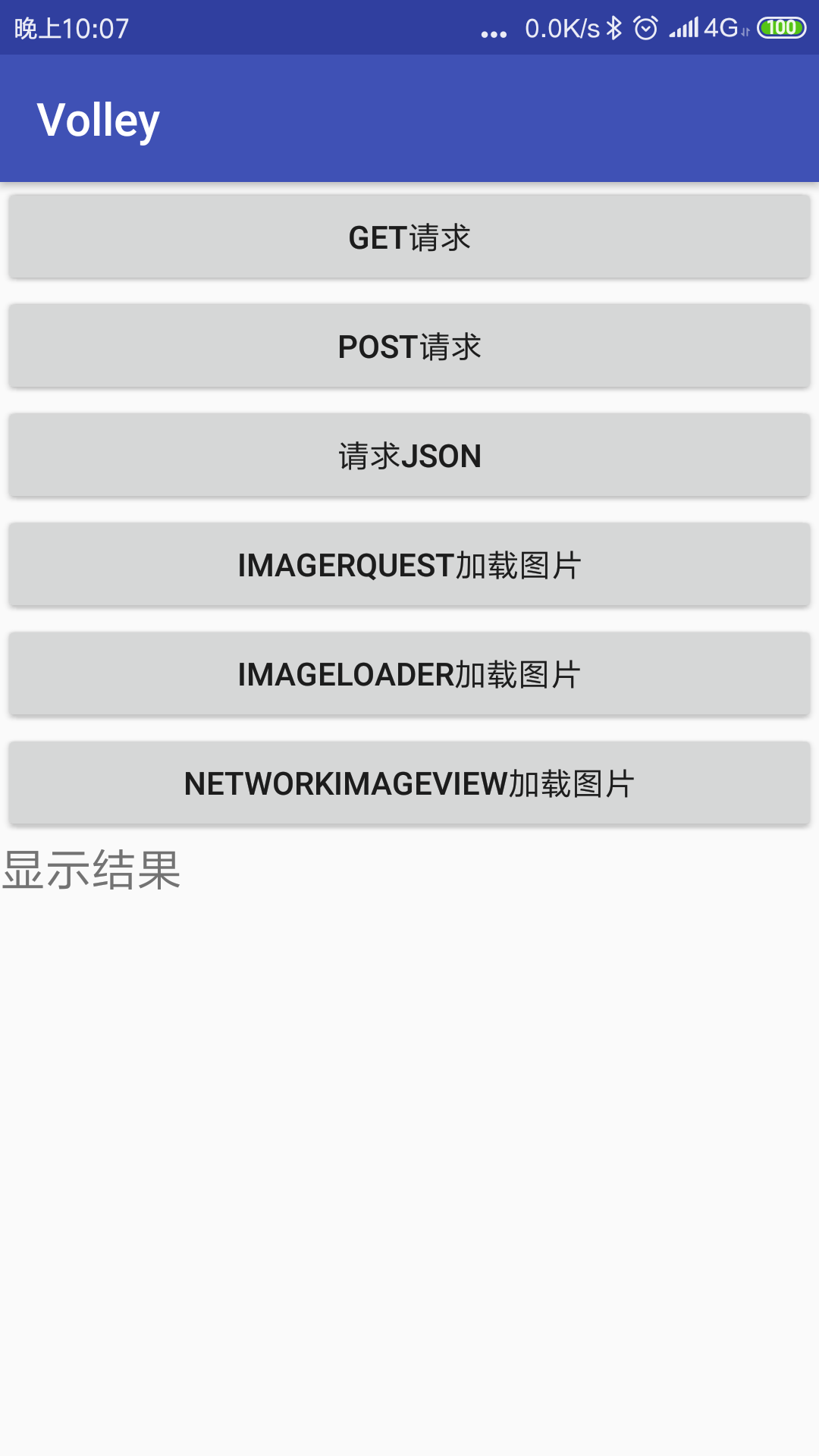First, we import this framework into the project:
implementation 'com.mcxiaoke.volley:library:1.0.19'
Add network permissions to the Android manifest file:
<uses-permission android:name="android.permission.INTERNET"/>
Here is our homepage layout:
In this layout, we have made a button for all the functions of the Volley framework. After pressing the button, the result will be displayed under "display result". A ScrollView is used under the display result, and a Textview and Imageview are nested under the ScrollView to display the pictures and texts after we have successfully loaded them.

Here is the code of the homepage layout:
<?xml version="1.0" encoding="utf-8"?>
<LinearLayout xmlns:android="http://schemas.android.com/apk/res/android"
xmlns:app="http://schemas.android.com/apk/res-auto"
xmlns:tools="http://schemas.android.com/tools"
android:layout_width="match_parent"
android:layout_height="match_parent"
android:orientation="vertical"
tools:context=".MainActivity">
<Button
android:id="@+id/get"
android:layout_width="match_parent"
android:layout_height="wrap_content"
android:text="Get request" / >
<Button
android:id="@+id/post"
android:layout_width="match_parent"
android:layout_height="wrap_content"
android:text="Post request" / >
<Button
android:id="@+id/json"
android:layout_width="match_parent"
android:layout_height="wrap_content"
android:text = "request JSON" / >
<Button
android:id="@+id/ImageRquest"
android:layout_width="match_parent"
android:layout_height="wrap_content"
android:text="ImageRquest load image" / >
<Button
android:id="@+id/ImageLoader"
android:layout_width="match_parent"
android:layout_height="wrap_content"
android:text="ImageLoader load image" / >
<Button
android:id="@+id/NetWorkImageView"
android:layout_width="match_parent"
android:layout_height="wrap_content"
android:text="NetWorkImageView load picture" / >
<TextView
android:text = "show results"
android:textSize="20sp"
android:layout_width="wrap_content"
android:layout_height="wrap_content" />
<ImageView
android:visibility="gone"
android:id="@+id/iv_volley"
android:layout_width="wrap_content"
android:layout_height="wrap_content" />
<com.android.volley.toolbox.NetworkImageView
android:id="@+id/NetWork"
android:visibility="gone"
android:layout_width="200dp"
android:layout_height="200dp" />
<ScrollView
android:layout_width="match_parent"
android:layout_height="match_parent">
<TextView
android:id="@+id/tv_volley_result"
android:layout_width="match_parent"
android:layout_height="match_parent" />
</ScrollView>
</LinearLayout>
In order to implement the ImageRequest request, there are three steps to make the ImageRequest request, namely:
-
Create a request queue
-
Create a request
-
Add the created request to the request queue
When creating a request, you must write two listeners at the same time, one is to implement the request and correctly accept the data callback, the other is the callback after an exception. Here we use the image website directly:
http://img5.mtime.cn/mg/2016/10/11/160347.30270341.jpg
The core code is as follows:
imagerequest.setOnClickListener(new View.OnClickListener() { @Override public void onClick(View view) { // 1 Create a request queue RequestQueue requestQueue = Volley.newRequestQueue(MainActivity.this); // 2 Request to create a picture String url = "http://img5.mtime.cn/mg/2016/10/11/160347.30270341.jpg"; ImageRequest imageRequest = new ImageRequest(url, new Response.Listener<Bitmap>() { @Override public void onResponse(Bitmap bitmap) { // Picture received correctly iv.setVisibility(View.VISIBLE);//Make picture visible iv.setImageBitmap(bitmap);//Pictures to be accepted Bitmap Object passed into our imageview Among } }, 0, 0, Bitmap.Config.RGB_565, new Response.ErrorListener() { //The first two parameters of 0 and 0 represent the maximum width and height of the loaded image, and the following parameters Bitmap.Config.RGB_565 Indicates the quality of the picture @Override public void onErrorResponse(VolleyError volleyError) { iv.setImageResource(R.drawable.test); } }); // 3 Add request to request queue requestQueue.add(imageRequest); } });
The Java code of all main activities is as follows:
import android.graphics.Bitmap; import android.support.v7.app.AppCompatActivity; import android.os.Bundle; import android.view.View; import android.widget.Button; import android.widget.ImageView; import android.widget.TextView; import com.android.volley.AuthFailureError; import com.android.volley.Request; import com.android.volley.RequestQueue; import com.android.volley.Response; import com.android.volley.VolleyError; import com.android.volley.toolbox.ImageRequest; import com.android.volley.toolbox.JsonArrayRequest; import com.android.volley.toolbox.JsonObjectRequest; import com.android.volley.toolbox.NetworkImageView; import com.android.volley.toolbox.StringRequest; import com.android.volley.toolbox.Volley; import org.json.JSONObject; import java.util.HashMap; import java.util.Map; public class MainActivity extends AppCompatActivity { private Button get; private Button post; private Button json; private Button imagerequest; private Button imageload; private Button netWorkImageView; private ImageView iv; private NetworkImageView network; private TextView tv_volley_result; @Override protected void onCreate(Bundle savedInstanceState) { super.onCreate(savedInstanceState); setContentView(R.layout.activity_main); initview(); initListener(); } public void initview()//It's a good programming paradigm to write the logic of the control to be initialized here { get=findViewById(R.id.get); post=findViewById(R.id.post); json=findViewById(R.id.json); imagerequest=findViewById(R.id.ImageRquest); imageload=findViewById(R.id.ImageLoader); netWorkImageView=findViewById(R.id.NetWorkImageView); iv=findViewById(R.id.iv_volley); network=findViewById(R.id.NetWork); tv_volley_result=findViewById(R.id.tv_volley_result); } public void initListener() { get.setOnClickListener(new View.OnClickListener() { @Override public void onClick(View view) { //Create a request queue RequestQueue requestQueue=Volley.newRequestQueue(MainActivity.this); //Create a request String url="http://gank.io/api/xiandu/category/wow"; StringRequest stringRequest=new StringRequest(url, new Response.Listener<String>() { //Callback after correctly accepting data @Override public void onResponse(String response) { tv_volley_result.setText(response); } }, new Response.ErrorListener() {//Listening callback after exception @Override public void onErrorResponse(VolleyError error) { tv_volley_result.setText("Loading error"+error); } }); //Add the created request to the request queue requestQueue.add(stringRequest); } }); post.setOnClickListener(new View.OnClickListener() { @Override public void onClick(View view) { // 1 Create a request queue RequestQueue requestQueue = Volley.newRequestQueue(MainActivity.this); // 2 Create a post request String url = "http://api.m.mtime.cn/PageSubArea/TrailerList.api"; StringRequest stringRequest = new StringRequest(Request.Method.POST, url, new Response.Listener<String>() { @Override public void onResponse(String s) { tv_volley_result.setText(s); } }, new Response.ErrorListener() { @Override public void onErrorResponse(VolleyError volleyError) { tv_volley_result.setText("request was aborted" + volleyError); } }) { @Override protected Map<String, String> getParams() throws AuthFailureError { Map<String, String> map = new HashMap<String, String>(); // map.put("value1","param1"); return map; } }; // 3 take post Request added to queue requestQueue.add(stringRequest); } }); json.setOnClickListener(new View.OnClickListener() { @Override public void onClick(View view) { // 1 Create a request queue RequestQueue requestQueue = Volley.newRequestQueue(MainActivity.this); // 2 Create a request String url = "http://gank.io/api/xiandu/category/wow"; //JsonArrayRequest jsonObjectRequest2=...... JsonObjectRequest jsonObjectRequest = new JsonObjectRequest(url, null, new Response.Listener<JSONObject>() { @Override public void onResponse(JSONObject jsonObject) { tv_volley_result.setText(jsonObject.toString()); } }, new Response.ErrorListener() { @Override public void onErrorResponse(VolleyError volleyError) { tv_volley_result.setText("request was aborted" + volleyError); } }); // 3 Add the created request to the request queue requestQueue.add(jsonObjectRequest); //After this step, you can use our json Parsed } }); imagerequest.setOnClickListener(new View.OnClickListener() { @Override public void onClick(View view) { // 1 Create a request queue RequestQueue requestQueue = Volley.newRequestQueue(MainActivity.this); // 2 Request to create a picture String url = "http://img5.mtime.cn/mg/2016/10/11/160347.30270341.jpg"; ImageRequest imageRequest = new ImageRequest(url, new Response.Listener<Bitmap>() { @Override public void onResponse(Bitmap bitmap) { // Picture received correctly iv.setVisibility(View.VISIBLE);//Make picture visible iv.setImageBitmap(bitmap);//Pictures to be accepted Bitmap Object passed into our imageview Among } }, 0, 0, Bitmap.Config.RGB_565, new Response.ErrorListener() { //The first two parameters of 0 and 0 represent the maximum width and height of the loaded image, and the following parameters Bitmap.Config.RGB_565 Indicates the quality of the picture @Override public void onErrorResponse(VolleyError volleyError) { iv.setImageResource(R.drawable.test); } }); // 3 Add request to request queue requestQueue.add(imageRequest); } }); imageload.setOnClickListener(new View.OnClickListener() { @Override public void onClick(View view) { } }); netWorkImageView.setOnClickListener(new View.OnClickListener() { @Override public void onClick(View view) { } }); } }
The following figure is obtained:

Good luck, success!!
